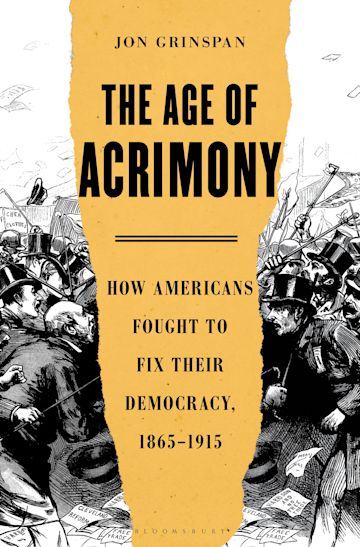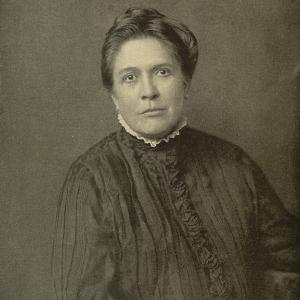Lindsay Chervinsky reviews The Age of Acrimony: How Americans Fought to Fix Their Democracy, 1865-1915, “… the dirty tale of how democracy got clean” by Jon Grinspan.
I’m excited to be back with you all to share a recent read that completely changed how I think of a “lost period” of American history. The Age of Acrimony: How Americans Fought to Fix Their Democracy, 1865-1915 by Jon Grinspan was first published in 2021, but I just got around to reading it. Grinspan presents a compelling, succinct story of the “origin story of normal politics … the dirty tale of how democracy got clean.”

Have you ever tried to list all the American presidents in order? I know a lot of kids had to memorize a rhyme in school, but if I did, I’ve long since forgotten it. I can get all the names but there are two fuzzy periods for me where the order gets wonky: the late 1840s to early 1850s and the 1880s to early 1890s. Perhaps it’s because the presidents are just so darn meh or maybe it’s because we haven’t really understood the critical turning points of those decades. The Age of Acrimony does two things well. First, it challenges us to reconsider the decades after the Civil War in a powerful way. Second, it’s creatively written and offers an unusual and interesting structure.
Politics in the decades after the Civil War were messy, violent, chaotic, and corrupt. White supremacists in the South enforced regimes through violence and political machines “operated as organized crime syndicates,” and business leaders brutally suppressed labor movements with the enthusiastic cooperation of the judicial system.
Electoral results reflected this chaos. The period witnessed one impeachment, two presidential elections in which the Electoral College winner lost the popular vote, and three presidential assassinations. Let me say that again because it bears repeating. Three presidential assassinations. And we think politics is violent today.
And yet, politics were also fun, meaningful, and full of opportunities. The average voter turnout was 77%, which is far higher than any other period in American history. Frequent and enthusiastic voters included immigrant, young, poor, working class, and Black Americans. They turned out for two reasons. Campaigns were can’t-miss events with wild rallies, street-corner debates, costumes, fireworks, and beer-drenched barbecues. In an age before television and social media, there was no better entertainment.
Second, politics offered real personal fulfillment. Tribal partisanship broke down along racial, ethnic, and religious lines. Communities gathered within political parties, providing fertile ground for friendships, networking opportunities, and romance. Political machines rewarded loyal operatives with education and jobs and took care of their families if they fell ill.
Around 1900, politics began to transform from a “public, partisan, passionate system into a more private, independent, retrained one.” Political conversations no longer took place in public but behind closed doors. Decorum and civility replaced violence and partisanship. Grinspan argues that these changes made possible the social reforms of the Progressive Era, including child labor laws and pure food acts. The changes also led to a participation crash. In the early 20th century, turnout had fallen by one-third and hovered in the 40s for decades. Young, immigrant, and working-class voters were the first to skip elections and turnout in these groups has never recovered.
I had always viewed the elimination of the spoils system and the reform of politics as a net positive for American society. I still think that’s mostly true, but Grinspan challenged me to see the benefits of a more raucous political world. I think he’s right that our ideas about “normal politics” didn’t emerge until the 20th century. It’s important to know what came in the messy decades from the Founding to Reconstruction to have a better sense of what came before.

Grinspan’s second major contribution is a writing win. As an author myself, I’m always fascinated by how other writers piece together a narrative. Which characters do they center? How do they tell a story? What moves the argument? Grinspan centers his story around the father-daughter duo William and Florence Kelley. Together, their lives span over a century in which the United States went from a baby nation fighting the War of 1812 against the British to an empire on the world stage.
William “Pig Iron” Kelley, known for his support for iron workers, was a self-made man who won national acclaim on the speaking circuit. He shared the stage with Frederick Douglass and Anna Dickinson and advocated for women’s suffrage with Susan B. Anthony. After his election to Congress, he became fast friends with Abraham Lincoln and was an ardent supporter of abolition. In Kelley’s later years, he increasingly pursued a vision of social democracy that focused on the economic plight of white workers at the expense of Black Americans in the South.
This moral failing was a disappointing one for the reader. Kelley’s betrayal of the Black voters who had long supported his campaigns mirrored the North’s turn away from Reconstruction. But it was almost more disappointing reading about the shift in one man. Kelley had bravely campaigned in the South for Black civil rights and his changing political positions appeared to defy logic.
Florence Kelley follows an equally dramatic arc. She started as a precious child who worshipped her father. After reading everything in her family’s extensive library, she attended Cornell University before joining her father as a political operative in Washington, D.C. Her life took an unexpected turn after traveling to Europe, where she met her husband. Their marriage paralleled her turn to radical socialism and her estrangement from her parents. She eventually fled her abusive husband and sought refuge in social reform work in Chicago. Alongside equally famous contemporaries like Jane Addams, Kelley pursued reforms that bettered the lives of immigrants, women, and children. I really enjoyed learning more about this dynamic duo (who I didn’t know about and maybe should have). But I loved that the book wasn’t just about them and isn’t a biography really. It pulls in the biggest characters, themes, and events of the day to tell a story through the lives of the Kelleys. That’s a tricky thing to do as a writer and Grinspan does it well. Highly recommend!
Lindsay M. Chervinsky, Ph.D. is a presidential historian and a regular guest on Listening to America. She is the author of several books including the forthcoming Making the Presidency: John Adams and the Precedents that Forged the Republic. She is on social media @lmchervinsky.
